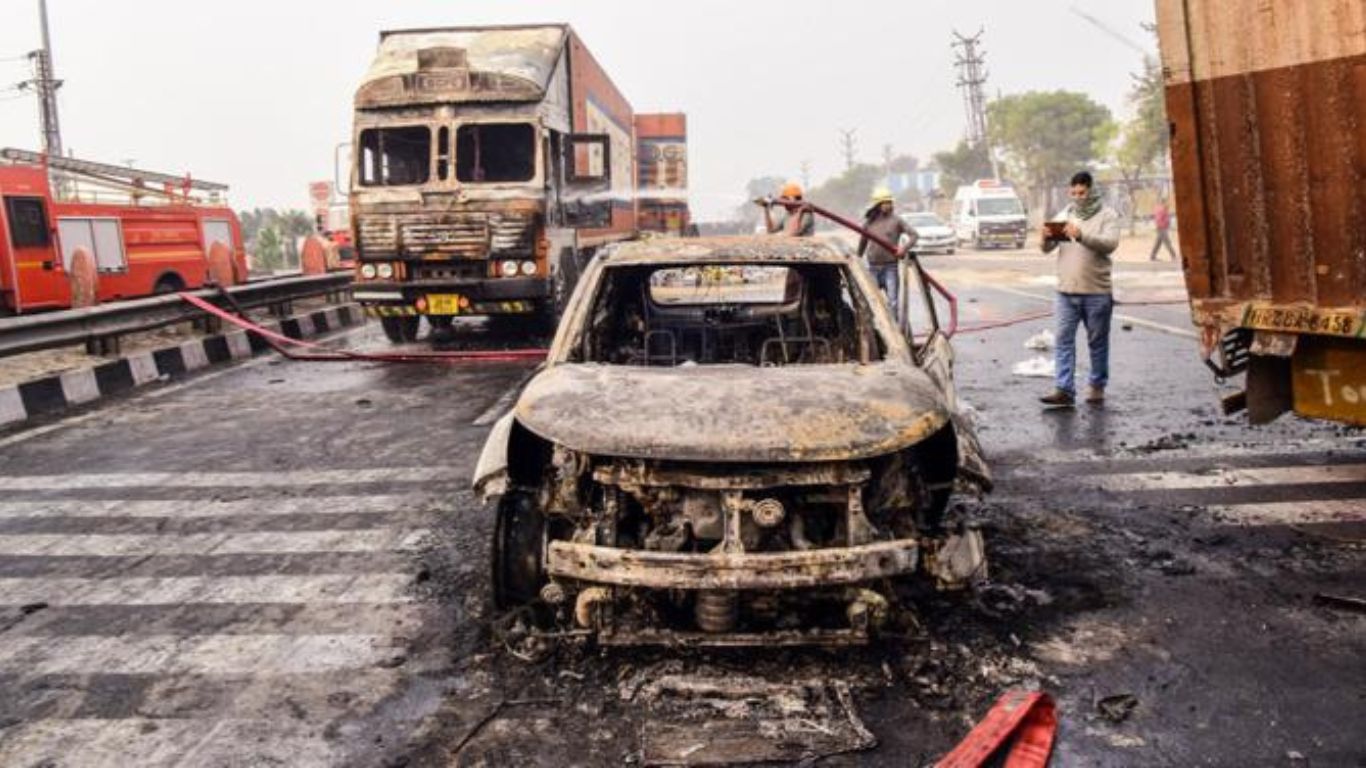In the early hours of December 20, 2024, a catastrophic accident on the Jaipur Ajmer Highway accident claimed the lives of at least 14 people, most of whom were burned alive. The death toll is expected to rise as many victims are still missing, and 30 others are battling for their lives, with seven on ventilators. This tragedy sheds light on the urgent need for road safety reforms in India, where road accidents have become alarmingly frequent and deadly.
The Incident: A Kafkaesque Inferno
The accident occurred when an LPG tanker attempting a U-turn was hit from behind by a truck. This collision triggered a massive explosion, described as a “red fireball,” which engulfed 40 vehicles in flames. By the time police and firefighters arrived, the inferno had reduced the scene to a charred wasteland, taking more than seven hours to extinguish.
Government Response
- Prime Minister Narendra Modi expressed his condolences and announced an ex-gratia payment of ₹2 lakh for the deceased’s families and ₹50,000 for the injured.
- The Rajasthan Police have registered a case of negligent driving, but the investigation faces hurdles as the drivers of the vehicles involved were among the fatalities.
- A Special Investigation Team (SIT) has been constituted to probe the causes and responsibilities for the incident.
A Longstanding Issue: Road Safety in Crisis
While this tragedy is one of the most recent, accidents involving hazardous materials are not new. Data from the Ministry of Road Transport and Highways reveals:
- Over 5,000 accidents involving hazardous materials occurred in 2021 alone, resulting in 1,000 deaths and numerous injuries.
- Unsafe transportation of hazardous substances has led to similar disasters, including a 1995 accident in Tamil Nadu, where an explosion involving a benzene-based tanker killed 93 people.
India’s Road Safety Record: Alarming Trends
- Global Comparison
- India accounts for 11% of global road accident deaths despite having only 1% of the world’s vehicle population.
- With 1.78 lakh fatalities in 2024, India far surpasses the US and China in road deaths.
- Expressways and Highways
- Expressways and highways constitute only 5% of Indian roads but account for 62.3% of accidents and 60.5% of fatalities.
- Casualty Growth Over Time
- 2003: 85,998 deaths in road accidents.
- 2019: 1.51 lakh deaths.
- 2024: 1.78 lakh deaths, a 207% increase over two decades.
Challenges in Addressing Road Safety
- Inaccurate Data
Road accident data in India is grossly underreported, with studies estimating 40–50% of cases going unreported. Accurate data is essential for targeted interventions. - Concurrent List Issues
- Roads and highways fall under the Concurrent List, creating overlaps in responsibilities between the Centre and states.
- This has led to inconsistent enforcement of road safety measures.
- Corruption in Law Enforcement
- Rampant corruption undermines the implementation of traffic laws and compromises road safety.
A Wake-Up Call: Learning from Global Practices
India’s road safety crisis stands in stark contrast to global trends. According to the WHO Global Status Report on Road Safety:
- Between 2010 and 2021, 108 countries reduced road accident deaths, with some achieving reductions of over 50%.
- Countries like Norway, Japan, and the UAE have shown that strong laws, better road design, and public awareness campaigns can significantly lower fatalities.
Solutions for India’s Road Safety Crisis
1. Improve Road and Vehicle Design
- Implement stricter safety standards for road construction and vehicle manufacturing.
- Ensure hazardous material transport follows globally accepted protocols.
2. Strengthen Laws and Enforcement
- Update traffic laws to align with international standards.
- Crack down on corruption within traffic law enforcement agencies.
3. Enhance Emergency Response
- Improve the availability and quality of emergency medical care on highways.
- Equip first responders with training and tools to handle hazardous material accidents.
4. Promote Sustainable Transportation
- Encourage walking, cycling, and public transportation to reduce the burden on highways.
- Invest in infrastructure that prioritizes safety for all road users.
5. Implement and Monitor Guidelines
- Simplify the recently introduced Indian Standard for Transportation of Dangerous Goods (IS 18149: 2023) to ensure comprehension and adherence by frontline workers.
The Jaipur Ajmer Highway tragedy is a stark reminder of India’s dire road safety challenges. With road accidents causing nearly 1.78 lakh deaths annually and millions more injured, urgent action is required. As a signatory to the UN Decade of Action for Road Safety (2021-2030), India must aim to reduce road traffic deaths by 50% by 2030. Achieving this goal will require political will, robust enforcement, and collective effort across all levels of government and society.
The lives lost on Indian roads should not just be statistics; they must serve as a call to action for systemic change.















